Body - Neck - Headstock
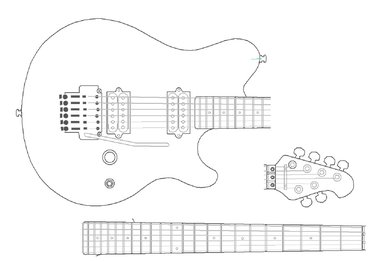
Body, neck and headstock, even without legs and hands, are clearly feminine beauty features of the guitar. And just as differences in faces and bodies have strong influence on the perception of beauty, every guitar has it own character. In the seventy-year history of the electric guitar, some types of guitars have either developed into generally accepted copy templates or serve as the basis for detailed changes.Therefore, the limits of creative freedom with electric guitar curves are relatively tight. To invent something that has not been there before is hardly possible.
Divide et impera, divide and rule!
This is the way to examine and understand the smallest optical differencies and their effects. For this I roughly divide the guitar into three areas according to the mode of action:
Body – Neck with Fretboard – Headstock,
to be abble to view them separately. A detailed technical drawing, called a blueprint, is useful, but not understandable for everyone. And comparing several blueprints on top of each over in detail is quite exhausting.
It is said that a picture is worth a thousand words, but is also leaves a lot of room for interpretation.
Numbers are missing to define exact dimensions and proportions. In comparison, a technical drawing or guitar blueprint "speaks" in numerical values. It'a a manageable set of dimension values thhis provided knowledge of formulas to help you understand them properly. For example the scale length, the position of the octave fret, etc. With that I would like to say that a discussion about guitars shapes is most useful when photos and drawings are accurately described with numbers and text descriptions. This is not only useful for guitar designer or self-builders, but also for collectors, buyers and other interested parties.
And just such a method is discussed in detail in my "Navigator" book.
Order of shapes and dimensions
String spread
The second most important feature is the string spread on the bridge and on the nut. These distances on the bridge determine whether there is enough space for the plucking fingers (or with a plectrum). This also applies to the distance between the strings on the nut, whereby the nut width for the chords grasping hand also influences the feel of the playing. Only then can you worry your head about the physical beauty ...
Guitar body
The guitar body is decisive for the recognition value of a brand, although there are also decent sounding models, almost without a body.It follows that the area between the fretboard and the bridge is most important for sound quality. Optics and body shapes play a more traditional role. I will describe, discuss and explain a lot about this later.
Guitar neck with fingerboard
The guitar neck with fingerboard are the area with the highest precision. The frets must be infixed with an accuracy of at least two tenths of a millimeter. Even if the neck is removable, i.e. fastened with screws, its position in relation to the body must also correspond to the above-mentioned precision. This applies if the bridge on the body cannot be moved towards the neck or back. Furthermore, the guitar neck with its cross-profile design ("neck back shapes") is a very sensitive matter. A guitarist's hand can feel the smallest differences in neck thickness, fingerboard width and the shape of the neck profile in all positions. When buying, you often test a lot of guitars before one is just right in the gripping hand. The many different neck profiles result from the variety of guitarist hands and their different anatomies and sizes.
Headstock
The headstock complements the physical beauty with a face and a company logo. It is also possible without a headstock. The mechanics are placed on the body and the instrument is headless. Traditionally, the machine heads are mounted on the headstock and the choice of headstock shape is relatively limited. In any case, it makes sense to position the machine heads so that the strings run parallel to the extended center line of the fingerboard.
Electric Guitar Navigator - The Book
Measure electric guitars shapes correctly
There are some good books and publications on design and construction of electric guitars and electric bass guitars. In this book I try to bring these topics from an unusual perspective to those who are both inexperienced and advanced guitarists, guitar owners, collectors or self-builders.
As a trained chemical laboratory technician, later electroplating technician and of course also as an amateur guitar maker and guitarist, I tend to measure everything in order to better understand the relationships.
The method for the systematic representation of the most important guitar parameters in coordinates can be very useful for a smooth communication between two or more guitar designers. Provided that everyone involved is ready to agree on the
N U L L P U N K T (origin-point) under the bridge.
Although the book offers a large number of drawings that can easily be scaled to 1:1 size, I am mainly concerned with the uniform method of establishing the identity of the guitar shapes in characteristic, as few coordinate pairs as possible.
And please, don't be afraid of math and geometry. What we need to understand the geometry of the electric guitar is knowledge up to 7th grade. Point, straight line, distance, length, half line, parallel, triangle, square, polygon, trapezoid, circle, etc. Center point, center line, angle, axis symmetry, rotation, reflection ... and of course the coordinate system.
Guitar in Ixes and Ypsilons
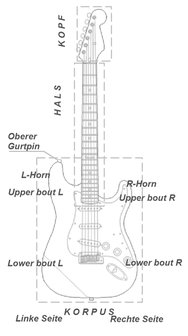
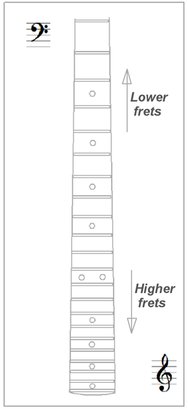
The anatomy of the electric guitar, electric bass, and other stringed instruments are usually described in their vertical, standing, or hanging position. Just as it is in the medical textbooks. Accordingly, a normal electric guitar has the body at the bottom, the neck in the middle and the head at the top. The body has a left and a right half, of which there is a lower and an upper quarter (bout). The lower strap pin is on the lower bout, the upper strap button is screwed onto the upper horn.
It is different with the neck or fingerboard, the lower frets are at the top and the upper frets (“higher frets”) are at the bottom, on the body. There's more physiology in there than anatomy, isn't it?
Musically - this is a musical instrument - “high” or “up” produces a higher frequency or a higher tone or pitch. After that, the electric guitar display should be "upside down" and almost all position descriptions are wrong. We have no choice but to look at the neck, or more precisely, the fingerboard, for ourselves. The neck as the support of the headstock remains in the usual representation.
The playing position
The playing position, whether sitting or standing, seems to be ideal for exploration, representation or precise measurement. If we place a coordinate system over a guitar in plan view, with the X-axis (the center line) running in the middle of the fingerboard and the Y-axis (the scale line) representing the scale length on the bridge, each point can be specified in exact numbers . The points serve as building blocks for the lines, curves, and other shapes. The third dimension, the Z-axis, can also be added as required.
Where is the neck zero point?
The illustration above is mainly suitable for showing the body outlines and overall proportions. For the headstock as a detail, it makes more sense, exceptionally, to position the zero point in the middle, on the front edge of the nut. So we move in the "small format", behind the fingerboard and can do without the negative X-coordinate numbers. For instruments with an additional zero fret in front of the nut, the zero point applies from the center of the profile of the crown of the zero fret.
The neck and fingerboard schema
Cross profiles of the neck
For the neck drawing, you also need the spatial Z-coordinate to describe the neck profile. For this, the zero point should be on the center line and on the fingerboard surface, flat, without a radius and without frets. The radius is “compound”, that is to say, it has a different height in individual layers, and since the frets wear out, they are not suitable as a measurement reference point.
Symmetry to the X axis
The front view of the classical concert guitar is more or less symmetrical to the center line that runs between the third and fourth strings. This line is suitable as the X coordinate axis. With the symmetry to the Y axis, the guitar offers too little in the front view. Because the scale and the bridge position are the most important specifications, the scale line Y has its place on the bridge area and not on the belt pin of the body.
The electric guitars are less "good" when it comes to symmetry and their asymmetry plays a major role in the design. Nevertheless, e.g. the eye-catching Flying V is an example of an almost perfect X-axis symmetry. Actually, we are investigating the opposite with the electric guitar mapping - the asymmetry, because the coordinate axes only serve as reference lines for the deviations of the measured values, starting from the zero value.
Tile-Puzzle
In the event that we want more precise position information of the contours and details of the instrument, in numbers, letters or other coding, we need a suitable grid system. A grid is of course nothing new, such as the transparent decimeter tiles proposed here over a guitar body. The numbered grid squares also have a close relationship with the ZERO POINT, whose position on the body depends on the scale length of the respective guitar.
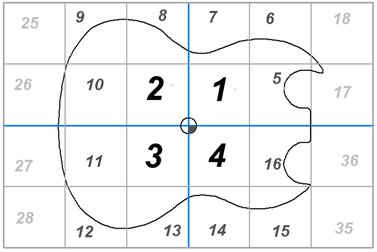
What is new is the spiral-running numbering or sequence, which takes over from the Cartesian coordinate system, the left-hand direction, the zero position and the X and Y coordinates.
Tile positions above an SG body
Downloads
Here you can find documents to download:

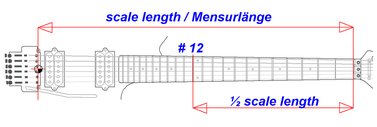
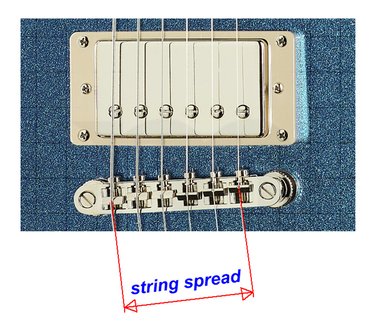
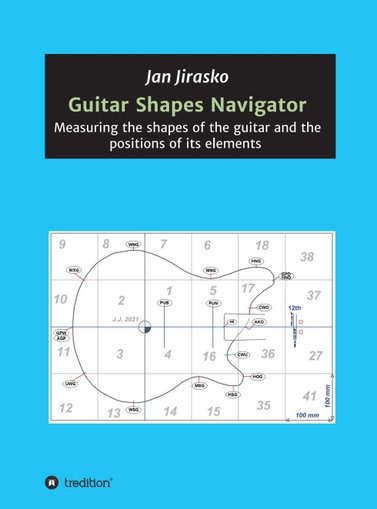
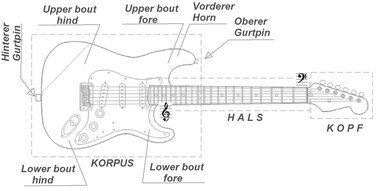
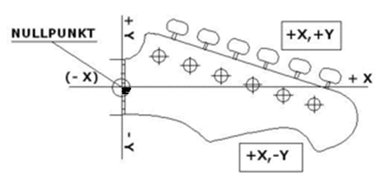
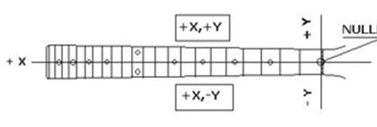
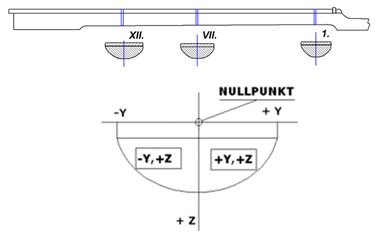
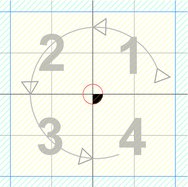
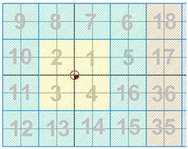
Comments (0)
No comments found!